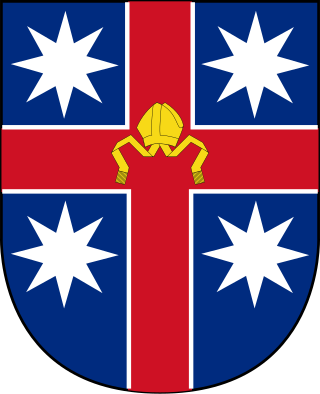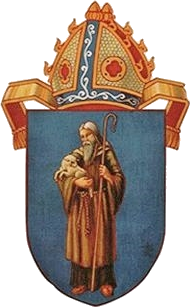
The Anglican Church of Australia, formerly known as the Church of England in Australia and Tasmania, is a Christian church in Australia and an autonomous church of the Anglican Communion. It is the second largest church in Australia after the Catholic Church. According to the 2016 census, 3.1 million Australians identify as Anglicans. As of 2016, the Anglican Church of Australia had more than 3 million nominal members and 437,880 active baptised members. For much of Australian history since the arrival of the First Fleet in January 1788, the church was the largest religious denomination. It remains today one of the largest providers of social welfare services in Australia.
The Melanesian Brotherhood is an Anglican religious community of men in simple vows based primarily in the Solomon Islands, Vanuatu, and Papua New Guinea.

The Anglican Church of Papua New Guinea is a province of the Anglican Communion. It was created in 1977 when the Province of Papua New Guinea became independent from the Province of Queensland in the Church of England in Australia following Papua New Guinea's independence in 1975.
The Most Reverend Geoffrey David Hand KBE GCL was an Australian-born Papua New Guinean Anglican bishop. He was the first Archbishop of the Anglican Church of Papua New Guinea.

The Anglican Diocese of Brisbane, also known as Anglican Church Southern Queensland, is based in Brisbane, Queensland, Australia. The diocesan bishop's seat is at St John's Cathedral, Brisbane. The diocese stretches from the south-eastern coastline of Queensland, down to the New South Wales border and west to the Northern Territory and South Australian borders. The diocese currently markets itself as "Anglican Church Southern Queensland" (ACSQ). The "Anglicare Southern Queensland" brand is also heavily promoted by the diocese.

John William Charles Wand, was an English Anglican bishop. He was the Archbishop of Brisbane in Australia before returning to England to become the Bishop of Bath and Wells before becoming the Bishop of London.

Lucian Tapiedi was a Papuan Anglican teacher who was one of the "New Guinea Martyrs." The Martyrs were eight Anglican clergy, teachers, and medical missionaries killed by the Japanese in 1942.

William Nigel Stock is a British Anglican bishop. From 2013 until his 2017 retirement, he was Bishop at Lambeth, Bishop to the Forces and Bishop for the Falkland Islands; from 2007 to 2013 he was Bishop of St Edmundsbury and Ipswich.
Paul Richardson is a British Roman Catholic priest and a former Anglican bishop.
John Wallace Chisholm, was an Australian divine who served as the tenth Anglican Bishop of Melanesia and first Archbishop of the Province of Melanesia. He was educated at Trinity College, University of Melbourne and ordained in 1947. His first post was as a Curate at St Stephen's Church, Rochester Row, Westminster after which he was Sub-Dean of Ss Peter and Paul Cathedral, Dogura, Territory of Papua and New Guinea. From his consecration as a bishop on 24 February 1964 until 1967 he was an Auxiliary Bishop of the Diocese of New Guinea when he became Bishop of Melanesia, a post he held until 26 January 1975 when the Diocese of Melanesia became a province and he automatically became Archbishop of Melanesia and Bishop of Central Melanesia. He died on 24 May, shortly after signing the last paperwork of the Province's creation process.

Leslie Wilkinson, FRAIA, was a UK-born Australian architect and academic. He was the founding dean of the faculty of architecture at University of Sydney in 1920. A traditionalist, he is known for his residential and church architecture.
Mervin Clyde Igara is a retired Papua New Guinean Anglican archbishop. He was Primate and Archbishop of the Anglican Church of Papua New Guinea from 2013 to 2017. He is married to Miriam and they have five children and five grandchildren.
Geoffrey Martyn Smith is an Australian Anglican bishop who has served as the Archbishop of Adelaide since 28 April 2017 and as Primate of Australia since 7 April 2020. Immediately prior to serving as archbishop, Smith was an assistant bishop, general manager and registrar of the Anglican Diocese of Brisbane.
Joseph Kifau Kopapa is a retired Papuan New Guinean Anglican bishop. He was Bishop of the Diocese of Popondota, from 2006 to 2010, and Archbishop and Primate of the Anglican Church of Papua New Guinea, from 2010 to 2012, when he resigned. He is married to Wasita and the couple has five children, three male and two female.
Bevan Stanley Meredith was an Anglican clergyman in Australia and Papua New Guinea who was Bishop of the New Guinea Islands (1977–1995) and Archbishop of Papua New Guinea (1990–1995).
Clarence Edgar Bester is a South African-born Australian bishop in the Anglican Church of Australia. He has served as the 11th Bishop of Wangaratta since February 2020.
The Community of the Ascension was an Anglican religious community for men in Goulburn, New South Wales, Australia. It was the first male Anglican religious order to be successfully established in Australia, in 1921, and existed until it dissipated in 1940 and then formally dissolved in 1943.

Sts Peter and Paul Cathedral is an Anglican cathedral in Dogura, Papua New Guinea. It was consecrated in 1939, just after the outbreak of World War II. It is the seat of the Bishop of Dogura in the Anglican Church of Papua New Guinea.
Newton Theological College is a Papua New Guinean educational institution in Popondetta, Papua New Guinea. It trains candidates for ordination in the Anglican Church of Papua New Guinea.

The Martyrs of New Guinea were Christians including clergy, teachers, and medical staff serving in New Guinea who were executed during the Japanese invasion during World War II in 1942 and 1943. A total of 333 church workers including Papuans and visiting missionaries from a range of denominations were killed during the invasion.








